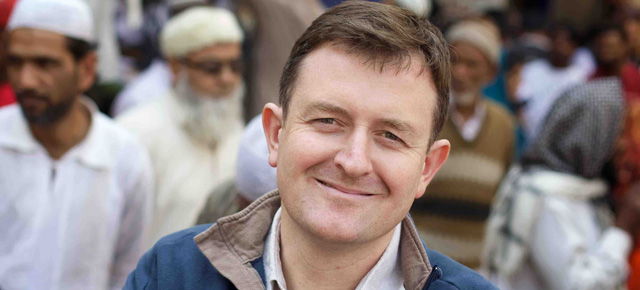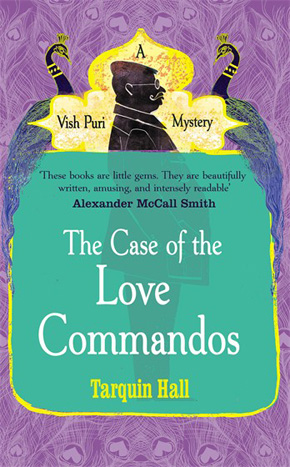Scents, sights and sounds of South Asia
by Tarquin HallMy first journey outside Europe and America took me to South Asia. I was 19 when I arrived in Karachi. It was three in the morning and I didn’t know a soul in the city. Outside the terminal, a crowd of rapacious taxi-wallahs swooped, grabbing at my bag, trying to pull me in different directions while each demanded to know my destination. I managed to pick one of them, fended off the others, and asked to be taken to a cheap hotel. I only came to know later that Karachi was in the grip of virtual civil war with two main ethnic factions fighting it out on the streets with automatic weapons and rocket-propelled grenades. But fortunately, we made it to a hotel in one piece and I managed a few hours sleep.
Author portrait © Tom Petrasik
At around ten o’clock, I was woken by a jarring cacophony of car horns, shouts and cries, screechy music blaring from speakers, and the bellowing of some animal. I went to investigate. Pushing open the front door of the hotel, I was assaulted by a rush of hot, fetid air and an effluvium of sewage and diesel fumes mixed with the pungent aroma of South Asian cooking. I remember standing there dumbfounded, watching the carnival of activity in the street, wondering if I had somehow been transported to a parallel dimension.
Everywhere there was colour: red turbans and prayer caps , tubs of ground spices arranged like paint palettes, bright orange tandoori chicken pieces. I could hardly see the surface of the footpath for all the activity.”
The whole place wore a dusty, bedraggled look with tangled wires suspended from telegraph poles and lopsided shops signs hanging at precarious angles. The buildings themselves appeared to have survived an earthquake, but only just. Hunks of concrete were missing from facades and streaks of filth stained the brickwork. And yet everywhere there was colour: red turbans and prayer caps bobbing along, tubs of ground spices arranged in rows like paint palettes, bright orange tandoori chicken pieces sizzling on a barbecue outside a pavement eatery. I could hardly see the surface of the footpath for all the activity. Pieces of iron were being soldered together, sparks of molten metal fizzing through the air and landing at the feet of pedestrians. Two men stood in a hole excavating a drain, while four others watched from above with concentrated frowns. Long lengths of sugar cane were crushed with a manual press mounted on a wooden cart, liquid dribbling into a glass. A tribesman in generous baggy cotton pants and long shirt sauntered past with a few kilims slung over one shoulder.
The bellowing was coming from a water buffalo, I realised. It was in the back of a small truck, the vehicle itself stuck in the middle of a logjam of traffic that stretched far down the street. The animal’s black snout protruded through the bars. Every now and then it exhaled, its nostrils flaring with spittle. The noise carried over the car horns, revving trucks engines and buzzing auto rickshaws like a foghorn.
I look back on those few minutes now as the most defining moments of my life. I suppose I might have shrunk from it all, retreating to my hotel to look for a way back to the dimension I had been brought up to believe was the real world. Instead, I was struck by an overwhelming urge to explore. And so I returned to my room, washed, and set off into the frenetic, exhilarating hubbub of Karachi.
Here are ten books, in no particular order, by authors who’ve also been bitten by the South Asia bug.
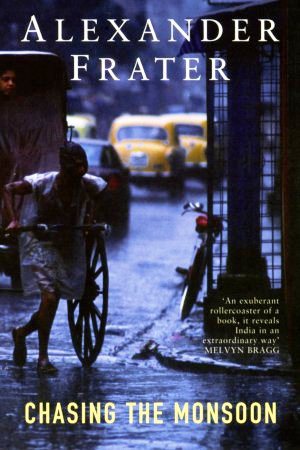 Chasing the Monsoon by Alexander Frater
Chasing the Monsoon by Alexander Frater
It’s rare for a travel narrative to be as gripping as good fiction, but Frater’s journey is a page-turner. And if the momentum of the journey doesn’t grab you, the evocative prose will. Setting off from the southernmost tip of India, where the monsoon comes rolling in – “the sky flared with the colours of coral and claret, the cool air carried a fragrance of lemons” – he follows its progress across the subcontinent, his journey ending in Cherapunjee, the wettest place on earth. Along the way he learns much about monsoon culture and how deeply it continues to affect the economics and livelihood of hundreds of millions of Indians.
Sorcerer’s Apprentice by Tahir Shah
This is vintage Shah, surely the most original travel writer of his generation and the antithesis of conventional Bill Bryson. A wild journey into Calcutta’s underbelly, it sees the author apprenticed to a cruel but brilliant magician who teaches him how to eat light bulbs and dip his hands into boiling oil. Shah is then sent on a journey of discovery across the subcontinent where he meets the most extraordinary collection of characters imaginable, including rationalists battling godmen and, in Bombay, a man whose family has long sold soda water and whose surname is, appropriately, Mister Sodawaterwallah.
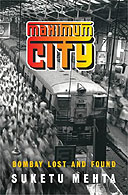 Maximum City by Suketu Mehta
Maximum City by Suketu Mehta
This is a portrait of surely the most intriguing city on earth: Bombay, or Mumbai. Mehta’s eye for detail, character and narrative is exceptional and the book left me with a collection of memories so vivid that I could almost swear they were my own. Exploring the city’s subcultures he meets every kind of villain, low-life and victim. He also dabbles in Bollywood. Best of all is the chapter on a Jain family who not only give up all their worldly possessions, but each other as well.
The Search for the Pink-Headed Duck by Rory Nugent
I read this book when I was researching my second book, To the Elephant Graveyard, which is also set in Assam in northeastern India. It’s never received the recognition that it deserves, but I rank it as a classic. The pink-headed duck hasn’t been spotted since 1935 and is thought to be extinct, and Nugent embarks on a wild journey along the Brahmaputra River in search of it. He visits the largest rhododendron forest in the world and encounters pirates, Gurkha separatists and Tantric necrophiliacs; all described with intelligent wit.
The Hall of a Thousand Columns by Tim Mackintosh-Smith
This is the second instalment of a gifted Arabist’s journey in the footsteps of the great 14th-century traveller Ibn Battuta. Although Mackintosh-Smith’s description and anecdotes can sometimes be somewhat laboured and his humour occasionally falls flat, the past and present blend seamlessly. I particularly enjoyed the chapters set in Delhi, where I have lived for a number of years, and learned much about its rich Islamic past.
Delhi: Adventures in a Megacity by Sam Miller
This book is tremendous fun – written with grace and humour and full of amusing facts and life-affirming encounters. Miller traverses Delhi by foot, not an easy task given the lack of pavements, monumental obstructions and insane traffic. But the rewards are great and Delhi is revealed as one of the most varied and complex capitals in the world with surprises around every corner.
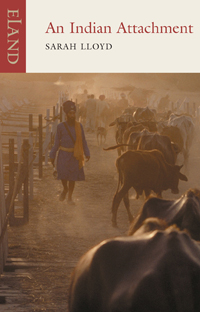 An Indian Attachment by Sarah Lloyd
An Indian Attachment by Sarah Lloyd
Sarah Lloyd is a true eccentric whose experiences beggar belief, even by Tahir Shah’s standards. This book tells of the two years she spent in rural India living in Punjab with an opium-addicted Sikh. “No other outsider has written so convincingly about life as the vast majority of Indians know it,” says the blurb and I would agree. This isn’t ‘Indiaaah’ but the culture laid bare, and Lloyd’s prose is crisp and beguiling.
Travels On My Elephant by Mark Shand
This is a Boy’s Own fantasy come true: Shand buys an elephant called Tara and rides her six hundred miles across India to the Sonepur Mela, the world’s oldest elephant market. It’s the kind of travel writing that I usually avoid – a journey with a gimmick. But Shand is a capable writer whose descriptions of the landscape are enchanting, and Tara makes for the best companion any traveller could ever hope for.
Chasing the Mountain of Light by Kevin Rushby
The Koh-i-Noor, or the Mountain of Light, is the world’s largest diamond. Discovered in India, it was seized by British agents from the Sikhs and now lies in the Tower of London, set in the crown of the Queen. Kevin Rushby sets off to retrace the history of the great jewel and serves up a beautifully written account of a meandering journey that takes him to villages, clandestine diamond markets and the palaces of deposed rajas.
Around India in 80 Trains by Monisha Rajesh
Monisha Rajesh achieved something I’ve longed to do myself: spend a month travelling across the length and breadth of India by train. This account of her 40,000-mile journey is honest and perceptive and at times laugh-out-loud funny. The fact that she grew up British but comes from an Indian family means that she often provides an unusual and insightful perspective. By the end I wanted to run down to New Delhi station and book myself on the next Shatabdi to Trivandrum.
Tarquin Hall is the author of the Vish Puri mysteries. His latest, The Case of the Love Commandos, a contemporary Romeo & Juliet story set within India’s caste system, is published in the UK by Hutchinson.
“These books are little gems. They are beautifully written, amusing and intensely readable.”
Alexander McCall Smith
vishpuri.com

